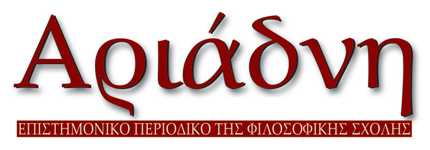Η Δίκη του καιρού και η Ερινύς του χρόνου : η αναστροφή της ασπίδας του Ετεοκλή στους Ἑπτὰ ἐπὶ Θήβας
DOI:
https://doi.org/10.26248/ariadne.v14i0.408Περίληψη
IN THE Seven against Thebes the shield is mainly a poetic metaphor of the defense mechanism at a moment of conflict and great fear. Whereas on the front side of the shield the bearing hero depicts a blazon image of himself meant to attack his opponent, its inner side implies a discourse made image, which the hero yearns to conceal and which eventually becomes the emblem of his opponent’s shield.
In the case of Eteocles’ imaginary shield, an image of Δίκη of καιρός is formed as a facet, in order that the hero becomes able to repulse every impending external attack, whereas on its inner side the image of Erinys is depicted, which is a mirror image of the Δίκη of time, namely the emblem of his own brother’s shield.
These conclusions result from a contextual reading of Eteocles’ “arming scene” together with the “sacrifice scene” of the Argive leaders in the prologue, as well as with the dramatic meaning of the focal “shield scene”, from a perspective of a psychological interpretation of drama.
Λήψεις
Δημοσίευση
Πώς να δημιουργήσετε Αναφορές
Τεύχος
Ενότητα
Άδεια
Οι εργασίες που δημοσιεύονται στο περιοδικό μπορούν να χρησιμοποιηθούν ελεύθερα για μη-εμπορικούς σκοπούς με την προϋπόθεση ότι γίνεται αναφορά στους συγγραφείς και την πρώτη δημοσίευση. Στην περίπτωση που το άρθρο αλλοιωθεί, τροποποιηθεί ή δημιουργηθεί κάτι νέο βασισμένο στο αρχικό, το έργο που θα προκύψει θα μπορεί να διανεμηθεί μόνο με την ίδια ή παρόμοια άδεια (Creative Commons Attribution-NonCommercial-ShareAlike 4.0 International License).


